How to Identify Dry Rot: Signs and Treatment
By Dave KileDry rot is a serious threat to wood structures but often goes unnoticed and untreated for years. It prefers hidden areas and places people neglect, such as cellars, attics, and the underside of decks and floorboards. Once detected, however, you can remove and/or treat the affected timbers and preserve the structural integrity of your building or deck.
What Is Dry Rot?
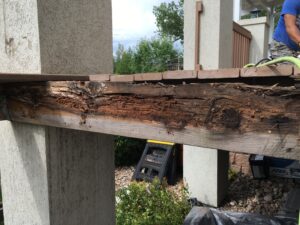 Dry rot is a form of timber decay that weakens structural timber. Like wet rot, it is a fungal decay that needs moisture to take root, but once established, a dry rot infestation doesn’t require damp timber to continue spreading. In fact, its tendrils, called hyphae, can grow several metres long below the wood surface, so its effects can stretch beyond the visible signs of dry rot. That’s why you hire professional surveyors to map the affected area’s extent and develop a dry rot treatment plan.
Dry rot is a form of timber decay that weakens structural timber. Like wet rot, it is a fungal decay that needs moisture to take root, but once established, a dry rot infestation doesn’t require damp timber to continue spreading. In fact, its tendrils, called hyphae, can grow several metres long below the wood surface, so its effects can stretch beyond the visible signs of dry rot. That’s why you hire professional surveyors to map the affected area’s extent and develop a dry rot treatment plan.
How to Identify the Signs of Dry Rot
Evidence of dry rot includes dry, dark timber with tell-tale cuboidal cracking that makes the wood crumble easily. Surfaces covered in a grey or whitish mat of web-like hyphae—the tendrils of the dry rot fungus—also indicate dry rot. The presence of a large mushroom-like body or fungus is another reliable sign.
While dry rot relies on wood for nutrients and water, it’s not confined to timber. It can also work through plaster and brick, so inspect your site thoroughly. The ability of dry rot to spread can make it appear in surprising places.
What Does Dry Rot Look Like?
At the early stages of growth, a large infestation of dry rot—also called brown rot—might look like a covering of fine, reddish dust. These are dry rot spores taking root in the wood. As this spore dust grows, the organism extends its hyphae to draw nutrients and water from the timber, like tree roots in the soil. As the hyphae filaments grow, they form a mat-like structure called mycelium, which resembles cotton wool. If allowed to grow further, dry rot will form a fruiting body with the characteristic look of fungal growth. This body—sometimes with concentric growth rings like a pancake—becomes a sporophore, shedding its spores in the hope of finding more timber to restart the dry rot life cycle. Even if it appears you have a small rot outbreak, consider having a professional conduct a dry rot survey.
Pictures of Dry Rot
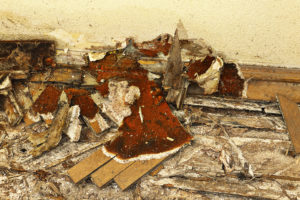
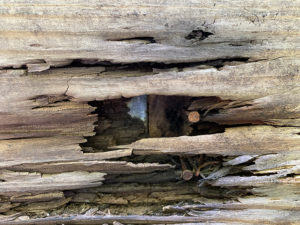
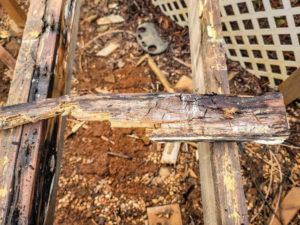
What’s the Smell of Dry Rot?
You might not notice its odour because dry rot grows in hidden areas. Or, if the odour is faint, you might grow accustomed to it over time. But up close, dry rot emits a musty and cellar-like odour or an earthy aroma, like mushrooms. So treat any odour associated with dampness as a warning sign that conditions are right for dry rot.
How to Know If It’s Dry Rot or Wet Rot?
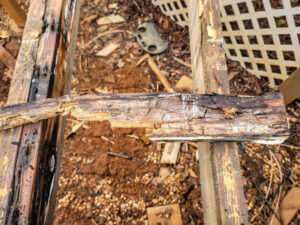 Both dry rot and wet rot require moisture to take root, but they look and act differently. Dry rot can take on a yellowish or sepia appearance, is dryer to the touch, and tends to spread over a larger area than wet rot. Dry rot turns wood a darker brown, shrinks it, and causes cracks across the wood grain. Mycelium may also grow in the wood or even a larger fruiting body.
Both dry rot and wet rot require moisture to take root, but they look and act differently. Dry rot can take on a yellowish or sepia appearance, is dryer to the touch, and tends to spread over a larger area than wet rot. Dry rot turns wood a darker brown, shrinks it, and causes cracks across the wood grain. Mycelium may also grow in the wood or even a larger fruiting body.
With active wet rot—usually caused by the Coniophora puteana fungus—there is often a source of moisture nearby, such as a leaky pipe or appliance. Or the wood might simply be in contact with the ground. Whatever the source, that moisture will permeate the wood, which becomes spongy or even soggy. A black fungus might also be present. In some cases, painted surfaces will wrinkle from wet rot, but at other times the paint conceals the decay. Test the wood for rot by probing it with a screwdriver. If the blade sinks into damp wood, it’s wet rot. Conversely, long-term wet rot can leave the wood dry and crumbly. This also occurs when the source of moisture is removed.
Why Does Dry Rot Occur?
For dry rot to flourish, it needs a welcoming substrate where spores can lodge and grow. The most inviting surface is lumber, which has a moisture content of around 30 per cent. Since kiln-dried lumber is much dryer than that, most dry rot starts with a damp problem, perhaps due to poor ventilation, wood in contact with the ground, or a leaky gutter. To minimise the opportunities for dry rot fungus to attack your deck, understand how to protect it. The type of wood doesn’t seem to be an important factor in dry rot, although timber from conifers seems more prone to it.
Does Fungus Cause Dry Rot?
Yes, dry rot is a fungus. In fact, several different types of fungi cause dry rot. In the UK and northern Europe, common dry rot fungi include Serpula lacrymans . This fungus favours areas where some fresh oxygen is available, typically near a gap to the outdoors, such as at window openings or between the foundation and wood structure. It can rapidly colonise timber.
Effects of Dry Rot
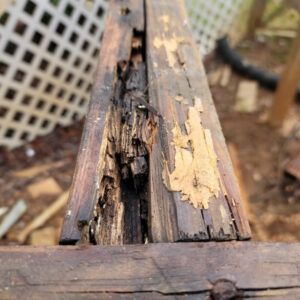 Dry rot weakens timber structures over time, leading to serious safety risks. Beyond compromising the strength of wood, it can also introduce health concerns and attract pests.
Dry rot weakens timber structures over time, leading to serious safety risks. Beyond compromising the strength of wood, it can also introduce health concerns and attract pests.
Wood Degradation
Dry rot digests cellulose, the component of wood that gives it strength and rigidity. Left unchecked, dry rot will consume all of the wood’s cellulose, leaving only lignin, a soft, flaky substance that you can crumble between your fingers. As a result, dry rot poses a grave hazard to the structural integrity of structures and buildings.
Dry Rot Health Risks
While dry rot primarily damages timber, the fungus itself can pose health concerns, particularly for those with respiratory sensitivities. Serpula lacrymans, the fungus responsible for dry rot, produces airborne spores that can trigger allergic reactions in some individuals, even in outdoor settings. Exposure to these spores may cause symptoms such as coughing, sneezing, eye irritation, or breathing difficulties, especially in people with asthma or weakened immune systems.
Although dry rot is not considered toxic, prolonged exposure to high concentrations of fungal spores can contribute to discomfort or irritation, particularly in damp environments where fungal growth is active. Regular inspections and prompt treatment of dry rot outbreaks help minimise both structural damage and potential health concerns.
Pest Infestation
Timber weakened by dry rot becomes more vulnerable to wood-boring insects, such as beetles and termites, which accelerate decay. The crumbling texture and loss of structural integrity provide an ideal habitat for these pests, leading to even more damage over time. In severe cases, insect infestations can spread beyond the affected timber, requiring both fungal treatment and pest control measures. Regular inspections and prompt dry rot treatment can help prevent insects from making weakened wood their home.
Does Dry Rot Spread?
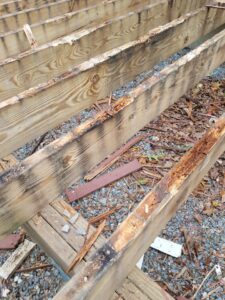 Yes, once established, the dry rot fungus thrives and spreads at moisture levels as low as 20 per cent. It grows its long strands of hyphae on and below the wood surface. Even pressure-treated lumber can get dry rot as the biocidal chemicals leach away or weaken over time.
Yes, once established, the dry rot fungus thrives and spreads at moisture levels as low as 20 per cent. It grows its long strands of hyphae on and below the wood surface. Even pressure-treated lumber can get dry rot as the biocidal chemicals leach away or weaken over time.
What Is the Treatment for Dry Rot?
Fungicides are effective if they reach the dry rot fungus, but since dry rot can spread invisibly below the wood surface, it’s difficult, if not impossible, to exterminate it completely. Therefore, the only treatment guaranteed to work is completely removing the affected area. Avoid homemade remedies, such as applying antifreeze, typically ethylene glycol. While this chemical is lethal to dry rot fungus, it’s not the intended use. It’s also difficult to force the antifreeze deep enough into the wood, and it will likely leach away and pollute the surrounding area.
Dry Rot Treatment Costs
Treatment costs depend on damage extent, affected area size, and whether professional help is needed. Minor cases may require fungicide and small timber replacements, while severe dry rot may demand extensive structural repairs.
Factors Affecting Costs:
- Extent of Damage: More widespread rot requires more timber replacement, increasing costs.<
- Location: Hard-to-reach areas (e.g., behind walls, under floorboards) raise labour expenses.
- Timber Replacement: High-quality, treated timber costs more but enhances durability.
- DIY vs. Professional: DIY is cheaper but risks missing hidden rot; professional treatment ensures thorough removal.
Estimated Costs:
- Small Repairs (DIY): £50–£200 for fungicide and minor timber replacement.
- Moderate Outbreak (Professional Repair): £500–£2,000, depending on the area affected.
- Severe Damage (Structural Repair): £2,000–£10,000+ for extensive timber replacement.
What Are Some Ways to Prevent Dry Rot?
To prevent a dry rot problem:
- Maintain airflow around structural timber because enclosed areas hold in moisture.
- Use only kiln-dried wood with a moisture content of 20 per cent or less and coat all sides with primer and paint.
- Stop water leaks from plumbing and prevent rain and snow from collecting on wood.
- Don’t allow sprinklers or water features to soak the wood.
- Build decks and other exposed surfaces at a slight pitch to shed water.
- Apply fungicidal treatments to protect wood from fungal growth before dry rot has a chance to develop.
- Invest in waterproofing tape for your deck substructure. Run your deck project measurements through our general estimate tool to determine how much Trex Protect tape is needed to protect deck joists, bearers, and rim.
Can I Treat Dry Rot Myself?
You can treat dry rot if you understand how to remove and replace the affected wood. But if you lack DIY skills, hire a professional builder/renovator. In most cases, they combine wood removal/replacement with timber treatment, typically applying a copper-based fungicide to the remaining wood. Be cautious about relying on epoxy-based compounds. While these can fill the voids left by dry rot and restore some strength to the wood, they will never be as strong as it once was. Never repair structural elements using epoxy. Protect all repairs from moisture by damp-proofing the timber.
___
Sources
Safeguard Europe. (n.d.). Dry rot: Causes, identification & treatment. https://safeguardeurope.com/dry-rot